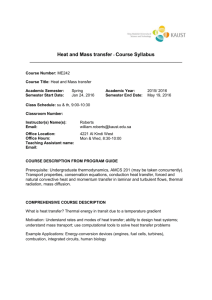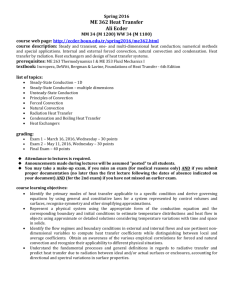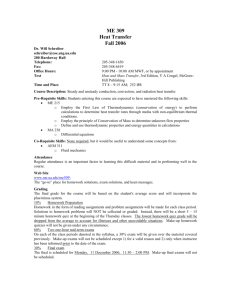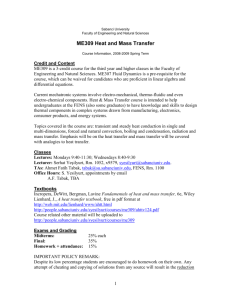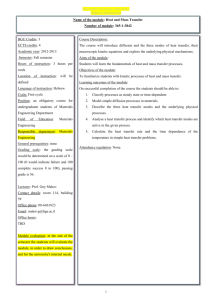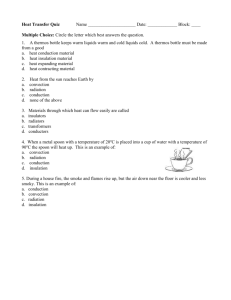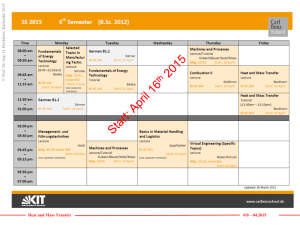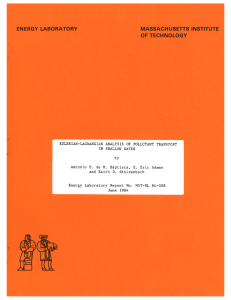Fall 2010 - ChE 370 - Department of Chemical, Biological and
advertisement
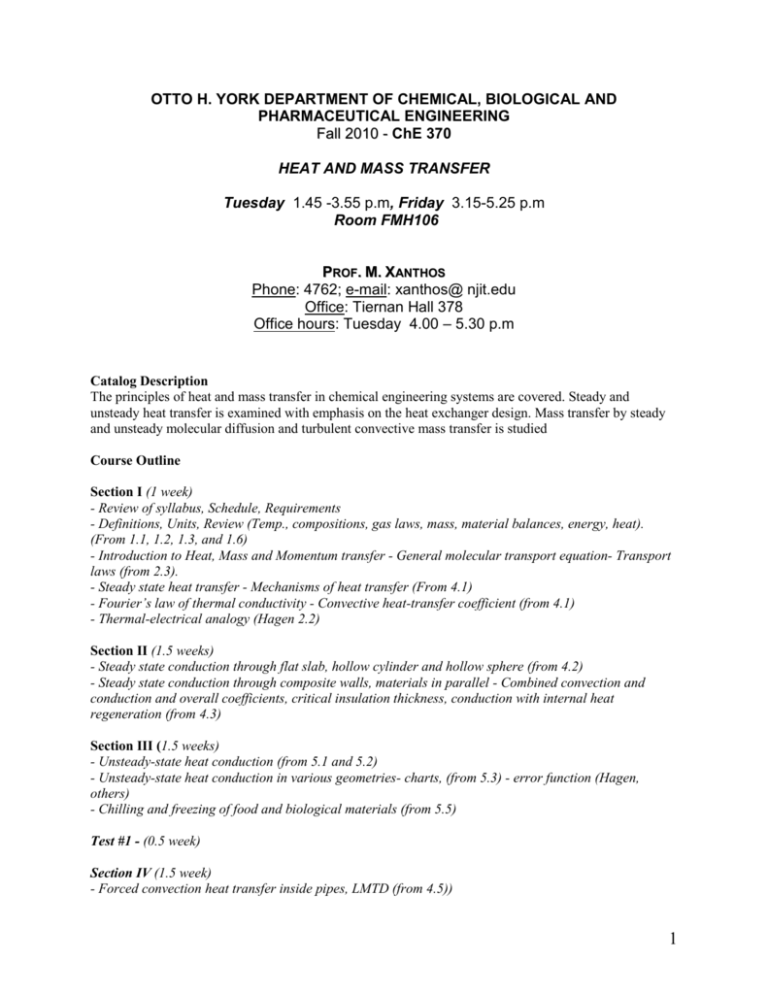
OTTO H. YORK DEPARTMENT OF CHEMICAL, BIOLOGICAL AND PHARMACEUTICAL ENGINEERING Fall 2010 - ChE 370 HEAT AND MASS TRANSFER Tuesday 1.45 -3.55 p.m, Friday 3.15-5.25 p.m Room FMH106 PROF. M. XANTHOS Phone: 4762; e-mail: xanthos@ njit.edu Office: Tiernan Hall 378 Office hours: Tuesday 4.00 – 5.30 p.m Catalog Description The principles of heat and mass transfer in chemical engineering systems are covered. Steady and unsteady heat transfer is examined with emphasis on the heat exchanger design. Mass transfer by steady and unsteady molecular diffusion and turbulent convective mass transfer is studied Course Outline Section I (1 week) - Review of syllabus, Schedule, Requirements - Definitions, Units, Review (Temp., compositions, gas laws, mass, material balances, energy, heat). (From 1.1, 1.2, 1.3, and 1.6) - Introduction to Heat, Mass and Momentum transfer - General molecular transport equation- Transport laws (from 2.3). - Steady state heat transfer - Mechanisms of heat transfer (From 4.1) - Fourier’s law of thermal conductivity - Convective heat-transfer coefficient (from 4.1) - Thermal-electrical analogy (Hagen 2.2) Section II (1.5 weeks) - Steady state conduction through flat slab, hollow cylinder and hollow sphere (from 4.2) - Steady state conduction through composite walls, materials in parallel - Combined convection and conduction and overall coefficients, critical insulation thickness, conduction with internal heat regeneration (from 4.3) Section III (1.5 weeks) - Unsteady-state heat conduction (from 5.1 and 5.2) - Unsteady-state heat conduction in various geometries- charts, (from 5.3) - error function (Hagen, others) - Chilling and freezing of food and biological materials (from 5.5) Test #1 - (0.5 week) Section IV (1.5 week) - Forced convection heat transfer inside pipes, LMTD (from 4.5)) 1 - Heat transfer outside various geometries in forced convection (from 4.6) - Natural convection heat transfer (from 4.7) - Dimensional Analysis- Buckingham Method -Dimensionless numbers (from 4.14, 3.11-13)) Section V (2 weeks) - Boiling, condensation (from 4.8) - Heat exchangers- fouling factors (from 4.9) - Heat transfer in agitated vessels, scraped surface heat exchangers (from 4.13) - Introduction to radiation heat transfer- Advanced principles (from 4.10, 4.11) Mid term and review (1 week) Section VI (2.5 weeks) - Introduction to mass transfer, Fick’s law (from 6.1) - Molecular diffusion in gases (from 6.2) - Molecular diffusion in liquids (from 6.3) - Molecular diffusion in biological solutions and gels (from 6.4) - Molecular diffusion in solids (from 6.5) Section VII (1.5 weeks) - Unsteady-state diffusion (from 7.1) - Convective mass transfer coefficients (from 7.2) - Analogies among mass, heat, and momentum transfer (from 7.3) - Diffusion of gases in porous solids and capillaries (from 7.6) Review for final exam (1 week) Final exam Textbook: Transport Processes and Separation Process Principles, 4th Edition, C.J. Geankoplis, Prentice Hall, Inc (2003). Additional sources of information: Heat transfer with Applications, K. D. Hagen, Prentice Hall (1999), ISBN 0-13-520941-2; Heat transfer, J.P. Holman, 10thth Ed. McGraw-Hill, Inc.;others. Course notes: Course notes containing relevant sections of each Chapter of Geancoplis and other books and problems will be posted at http://moodle.njit.edu Prerequisites: ChE 232, Math 222, ChE 260 Student evaluation: Test, 20%; Mid-term, 30%; Final Exam, 40%; Homework and class participation 10%. Note: NJIT Honor Code will be upheld and any violations will be brought to the attention of the Dean of Students. Students will be informed regarding modifications or deviations from the syllabus. 2
![Applied Heat Transfer [Opens in New Window]](http://s3.studylib.net/store/data/008526779_1-b12564ed87263f3384d65f395321d919-300x300.png)
